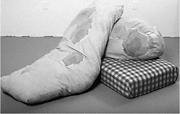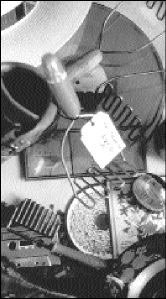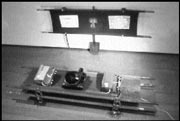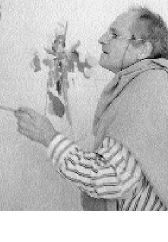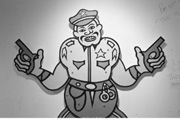A WOMAN’S WORK is never done. Sure, there’s that business of liberating oneself, but that’s a task made especially difficult when you consider the demands of work, household, maybe kids. So it’s no wonder that these days it’s artists who find the time to knit and sew. And they’re not just darning socks; they’re making objects that poke fun at their foremothers’ handiwork while thumbing their noses at the stuffy old patriarchy.
Domestically Engendered: Contemporary Fiber Art
Davidson Galleries, July 6-29
Staking their claim on the divergent domains of art history and craft, five women artists fuse visual language with exaggerated takes on domestic handiwork in “Domestically Engendered: Contemporary Fiber Art.” As the practically unavoidable grid structure inherent in fiber art is revealed by these artists in strikingly different ways, it becomes abundantly clear that this medium has formal affinities with modernist composition (think of Mondrian). For example, Lorre Hoffman’s Stone Quilt, a grid of stone-filled pouches, takes its cue from modern art.
Faith Ringgold and Elaine Reichek, both New York-based and widely collected by major museums, anchor the show. A pioneer in garnering recognition for women’s work as legitimate art, Ringgold managed to secure footing for quilts in the exclusive realm of “high art” as early as 1967. Her work combines folk art with painting, resulting in deceptively soft and jubilant quilts (she’s best know for her Dancing at the Louvre series) that confront issues of slavery, racism, and sexism. Reichek, featured last spring in a solo exhibition at the Museum of Modern Art, employs embroidery, knitting, and weaving to make statements about art history and gender divisions. Her cross-stitch Samplers mimic the homey, sentimental pieces over which women have so painstakingly toiled, replacing the delicately embroidered “Home Sweet Home” with quotations culled from art history, literature, science, mythology, and pop culture.
DRAWING RATHER shamelessly from Claes Oldenburg, Nora Auston’s plush, bloody, slab-of-meat sculpture draped over its mate does more than playfully dabble in vulgarity. These anthropomorphic objects are engaged in some kind of slo-mo dance. Auston uses tea, spices, and other natural substances as dyes (another borrowing from the domestic, this time from the kitchen). It’s a stretch, but Auston’s other batting-stuffed muslin pieces are intended to reflect the aesthetic schemas of Donald Judd’s wall pieces and Carl Andre’s floor installations.
Perhaps the strongest aspect of this group show is the inclusion of the witty and cutting performance artist Carrie O’Donoghue. The gallery will host two performances of The Betty Work, an ongoing project that revolves around Betty, a 1950s housewife character, and her apron-clad cohorts who stand for a collective “everywoman.” Betty enacts— often in extremely humorous incarnations—scenes of domestic labor and struggle. In “Thread,” which will be performed at the gallery on July 15 at 7pm, O’Donoghue acts the part of the bobbin to a sewing machine as a line of women iron madly. Known to add extra twists to her performances—passing the iron all over her body, stripping down and washing and ironing her own clothes, and other daring feats—O’Donoghue accompanies the performances by singing arias. She has the voice to carry it off, and the effect is both stunning and absurd.
This show presents artists who played a key role in the movement’s early days alongside artists venturing into new territory, obliterating any preconceptions of fiber art. This isn’t about wall hangings and brocades, but about the boundless possibilities of fabric and fiber in contemporary art.
